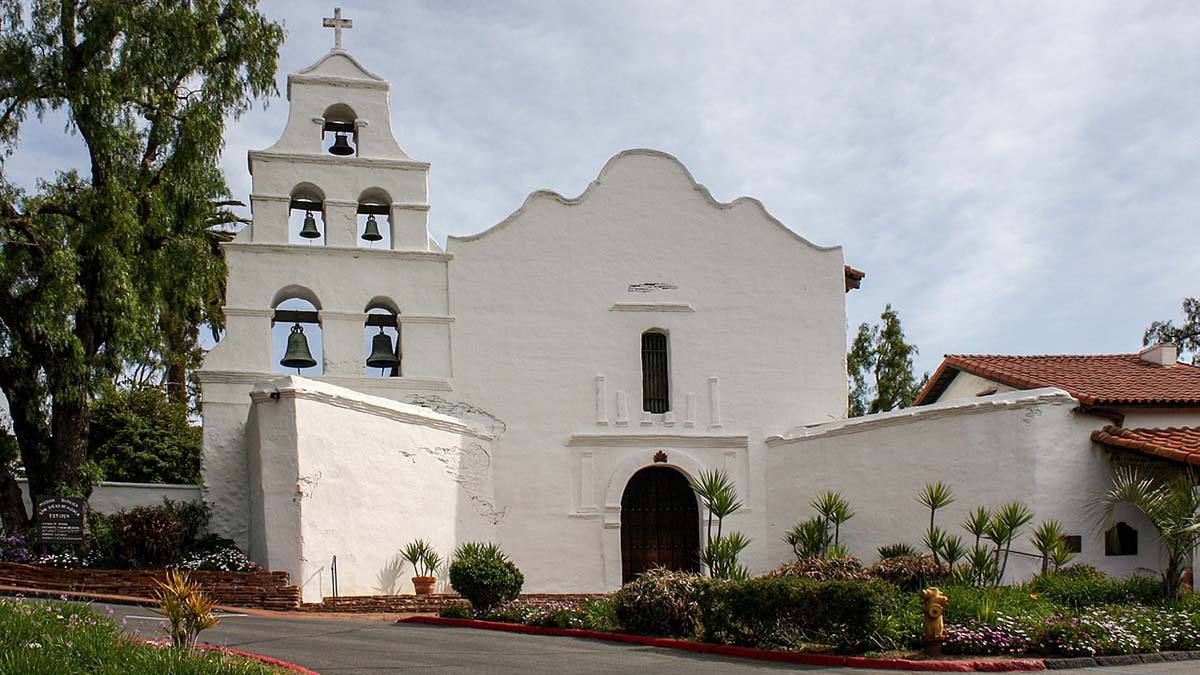
San Diego, California
by Troy Herrick
As you walk from the paved trolley stop into arid, sandy “Old Town” San Diego isn’t just a change of terrain, it‘s a step across the sands of time into the early 19th century when the settlement was in transition from Mexican pueblo to American frontier town.
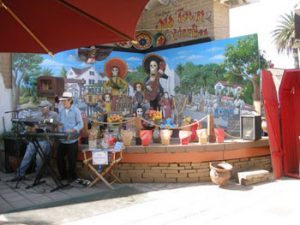 Get your bearings at the Interpretive Center inside the McCoy House just inside the park entrance. This reconstructed wooden structure, circa 1869, exhibits the local history. Displays outline the arrival of the Spanish in 1769, the construction of the Presidio (a Spanish fort) along with Mission San Diego de Alcala and the subsequent Christianization of the local Kumeyaay Indians. Exhibits also present Mexico’s independence from Spain in 1821 and the Mexican-American War in 1846. This war forced the sale of California to the United States followed by rapid settlement and Americanization.
Get your bearings at the Interpretive Center inside the McCoy House just inside the park entrance. This reconstructed wooden structure, circa 1869, exhibits the local history. Displays outline the arrival of the Spanish in 1769, the construction of the Presidio (a Spanish fort) along with Mission San Diego de Alcala and the subsequent Christianization of the local Kumeyaay Indians. Exhibits also present Mexico’s independence from Spain in 1821 and the Mexican-American War in 1846. This war forced the sale of California to the United States followed by rapid settlement and Americanization.
Complete your orientation by reviewing the scale model of the old town, circa 1872, inside the Rose-Robinson House Visitor Center then exit to the Plaza de Las Armas.
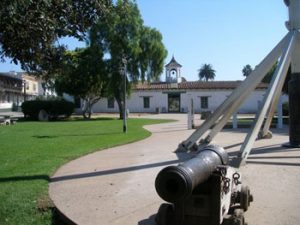 Those who have traveled throughout Latin America will notice something unusual about this Plaza de Las Armas – there is no Catholic church. Until 1868 when the Catholic Church was built, the padre said mass inside La Casa de Estudillo just across the plaza. The cupola and bell atop this house provides the only hint to this activity.
Those who have traveled throughout Latin America will notice something unusual about this Plaza de Las Armas – there is no Catholic church. Until 1868 when the Catholic Church was built, the padre said mass inside La Casa de Estudillo just across the plaza. The cupola and bell atop this house provides the only hint to this activity.
Built in 1827, La Casa de Estudillo depicts the lifestyle of a wealthy family of the period. Entering the hacienda from the plaza, you find the chapel and priest’s room to the immediate left just off the interior veranda. The dimly lit chapel houses an altar and a cabinet for storing a bible. The priest’s quarters contain a cot, piano and vestments.
All rooms inside the hacienda feature dark, heavy wooden beamed ceilings and sienna-colored clay tile floors. The dining table exudes power and authority; the central chair is more elaborate than the others. On the wall behind this chair you find a portrait of a Spanish Army Officer ready to size up the dinner guests. Heavy wooden dressers, linens, silverware, wash basins and a spinning wheel are prominently displayed.
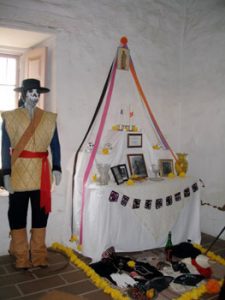 When I visited in October, the family room was decorated to celebrate the Mexican Day of the Dead (Dia de Los Muertos) which honors deceased relatives and friends. This event coincides with Halloween and the Catholic All-Saints Day. Typically the family sets up an altar with photos of deceased loved-ones surrounded by vessels for offerings like wine, salt, bread etc. Small skulls made from sugar are also displayed. Items of clothing may also be laid out in front of the altar. Furthermore, life-sized skeletons are seen as humorous so it came as no surprise to be greeted by one dressed as a vaquero (Mexican cowboy). Visitors should also note that there are no closets in which to keep this family’s skeleton when it is not in use.
When I visited in October, the family room was decorated to celebrate the Mexican Day of the Dead (Dia de Los Muertos) which honors deceased relatives and friends. This event coincides with Halloween and the Catholic All-Saints Day. Typically the family sets up an altar with photos of deceased loved-ones surrounded by vessels for offerings like wine, salt, bread etc. Small skulls made from sugar are also displayed. Items of clothing may also be laid out in front of the altar. Furthermore, life-sized skeletons are seen as humorous so it came as no surprise to be greeted by one dressed as a vaquero (Mexican cowboy). Visitors should also note that there are no closets in which to keep this family’s skeleton when it is not in use.
This house is one of three adobe brick homes in the old town. Adobe bricks are made from straw, sand, mud and manure. Wealthy families whitewashed the exterior adobe walls with a mixture of crushed seashells and lye. Less affluent families left the exterior in its natural brown state. All families, independent of social class, whitewashed the interior adobe walls as means of keeping the home cool during the hot weather.
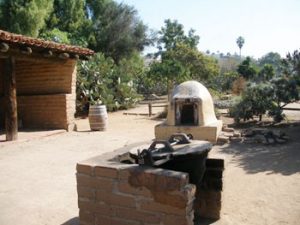 A short distance away at La Casa de Machado y Stewart, you find that the ceilings are constructed from cane or bamboo branches. The family table is also more basic than the previous one. Inside the main room, visitors find the family skeleton standing next to the altar, dressed as a woman.
A short distance away at La Casa de Machado y Stewart, you find that the ceilings are constructed from cane or bamboo branches. The family table is also more basic than the previous one. Inside the main room, visitors find the family skeleton standing next to the altar, dressed as a woman.
Meals were prepared on the veranda at the back of the house. This area included a cooking area (ornea) apart from the house and shaded with its own roof (romada) just in case a fire broke out. The back yard also features a dome-shaped brick oven known as an “orno”. The orno is a Moorish design dating to the time when the Muslims controlled Spain.
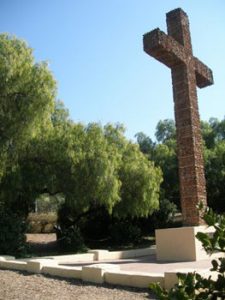 Enjoy a leisurely stroll around the town to discover a number of other homes and businesses, each with its own story. The Machado y Silvas house, circa the 1840s, has been divided into a restaurant and a gambling den. In the latter you can learn a 19th century game known as “lucky seven”. A short distance away, you also find a cigar and tobacco shop once owned by two enterprising French Canadians named Racine and Laramie.
Enjoy a leisurely stroll around the town to discover a number of other homes and businesses, each with its own story. The Machado y Silvas house, circa the 1840s, has been divided into a restaurant and a gambling den. In the latter you can learn a 19th century game known as “lucky seven”. A short distance away, you also find a cigar and tobacco shop once owned by two enterprising French Canadians named Racine and Laramie.
At this point you have likely earned some refreshments. The Casa de Reyes Restaurant has an outdoor patio where you can enjoy a frozen lime Margarita or a cold cerveza while being surrounded by vibrant colors and lively Mexican music.
Pry yourself away from the fiesta-like atmosphere near the patio, and walk along the Old Presidio Historic Trail to the site of the first Spanish mission in California at the top of lush Presidio Hill. Here you find a 20-foot cross constructed of brown bricks marking the site. This mission was destroyed in a Kumeyaay revolt and re-established at its present location approximately 5 miles away. The mission priests are commemorated by the statue of “the Padre” near the cross.
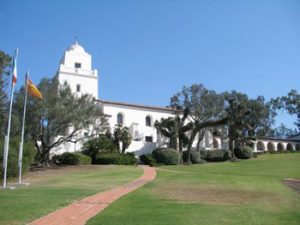 A short distance away, the Serra Museum honors Father Junipero Serra, the founder of the California Mission system. Terracotta tiles adorn this whitewashed adobe structure housing Indian, Spanish and Mexican belongings, cannons, cookware and paintings. Padre Serra’s journey throughout California is also outlined. Serra was a Franciscan and therefore took a vow of poverty. You can see his Spartan bedroom at the Mission San Diego de Alcala.
A short distance away, the Serra Museum honors Father Junipero Serra, the founder of the California Mission system. Terracotta tiles adorn this whitewashed adobe structure housing Indian, Spanish and Mexican belongings, cannons, cookware and paintings. Padre Serra’s journey throughout California is also outlined. Serra was a Franciscan and therefore took a vow of poverty. You can see his Spartan bedroom at the Mission San Diego de Alcala.
At the end of the day, enjoy a reasonably-priced Mexican dinner at the Casa Guadalajara Restaurant. You’ll know you are in the right place when you see staff making tortillas just inside the front entrance. I recommend the seafood chimichanga. After your meal, step back across the sands of time to the trolley stop and leave behind an age when life was much simpler.
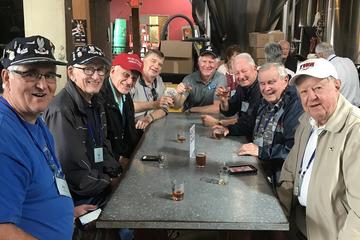
Private San Diego Brewery Tour
If You Go:
- Admission to Old Town State Historic Park is free. Take the trolley (Blue Line or Green Line) to Old Town Station. Trolley information is available at www.sdmts.com
- Find a map of Old Town San Diego at www.oldtownsandiegoguide.com
- The Rose-Robinson House is located at 4002 Wallace St. You can pick up a free walking tour map of Old Town San Diego here and arrange a free one-hour tour from a guide in period costume.
- The Old Presidio Historic Trail is found at the intersection of Mason Street and Juan Street. Follow the signs to the top of the hill.
- The Serra Museum is located at 2727 Presidio Dr. Admission was $5 at the time of my visit.
- The Casa Guadalajara Restaurant is located at 4105 Taylor St. www.bazaardelmundo.com
- The present-day Mission San Diego de Alcala is located at 10818 San Diego Mission Rd. Ride the trolley (Green Line) to Mission San Diego Station. Walk north on Rancho Mission and then turn right on San Diego Mission Road. The mission is approximately 500 yards on your left. Admission at the time of my visit was $3 per person. www.missionsandiego.com
About the author:
Troy Herrick, a freelance travel writer, has traveled extensively in North America, the Caribbean, Europe and parts of South America. His articles have appeared in Live Life Travel, International Living, Offbeat Travel and Travels Thru History Magazines. He also penned the travel planning e-book entitled ”Turn Your Dream Vacation into Reality: A Game Plan for Seeing the World the Way You Want to See It” – www.thebudgettravelstore.com/page/76972202 based on his own travel experiences over the years. Plan your vacation at his www.thebudgettravelstore.com and his www.plan-a-dream-trip.com sites.
Photo credits:
First Mission San Diego by Bernard Gagnon / CC BY-SA
All other photos by Diane Gagnon. A freelance photographer, she has traveled extensively in North America, the Caribbean, Europe and parts of South America. Her photographs have accompanied Troy Herrick’s articles in Live Life Travel, Offbeat Travel and Travels Thru History Magazines.



Leave a Reply
You must be logged in to post a comment.